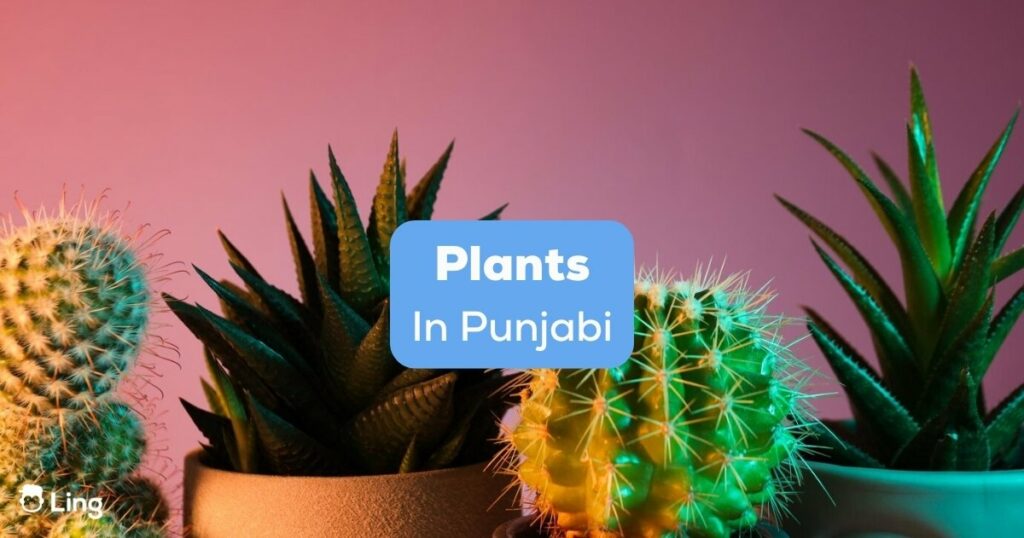The colorful and fascinating world of plants in Punjab is a sight to behold, as the region’s rich landscapes are filled with captivating flora. From the lush fields to the enchanting gardens, the people of Punjab have developed a deep connection with their native plants, which hold significant cultural and medicinal value.
As we explore this beautiful corner of India, we will uncover the essential words and phrases used in the Punjabi language to describe these remarkable plants. Join us on this delightful journey to learn more about plants in Punjabi and the language that brings them to life.
Common Plants In Punjabi And Their Cultural Significance
Let’s explore the cultural significance of some common plants in the region. In this section, we’ll learn about trees, fruits and vegetables, and flowers native to Punjab and how they have impacted the culture, environment, and traditional medicine practices.
Trees
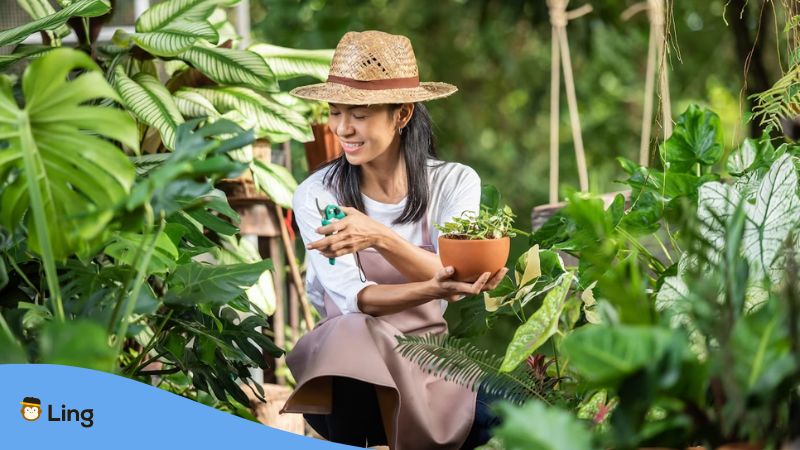
Sacred Fig – Peepal (ਪੀਪਲ)
The Peepal (ਪੀਪਲ) tree holds immense cultural and religious significance in Punjab, as it is considered sacred in Hinduism and Buddhism. Its wide canopy provides shade and shelter, while its leaves and bark are used in traditional medicine to treat various ailments, such as asthma and diabetes.
Banyan – Bohar (ਬੋਹੜ)
The Bohar (ਬੋਹੜ) tree, another sacred tree in Punjab, symbolizes longevity and wisdom due to its expansive roots and long lifespan. It usually serves as a gathering place for village meetings and ceremonies. Its leaves, bark, and roots have medicinal properties that help treat skin ailments and digestive issues.
The Neem Tree – ਨੀਮ
Revered for its potent medicinal properties, the Neem tree (ਨੀਮ) is a fast-growing tree and is a vital part of Punjabi traditional medicine. Its leaves, bark, and seeds contain compounds that provide antibacterial, antifungal, and anti-inflammatory benefits, making it a go-to remedy for numerous health conditions.
ਖੜੀ (Khari) – Acacia
The ਖੜੀ, or acacia tree, is valued for its durable wood, which is often used for furniture and construction.
Additionally, conventional medicine has used its gum to treat various ailments, such as diarrhea, coughs, and skin conditions.
Almond – Badaam (ਬਦਾਮ)
The Badaam tree (ਬਦਾਮ), known for its nutrient-rich almonds, plays a significant role in Punjab’s culinary traditions. Almonds are used in various dishes and sweets, and their oil is prized for its health benefits, including improving heart health and skin complexion.
Indian Rosewood – Shesham (ਸ਼ੇਸ਼ਮ)
The Shesham tree (ਸ਼ੇਸ਼ਮ), also known as Indian Rosewood, is the state tree of Punjab. Its durable wood is used for furniture making. At the same time, its leaves, bark, and seeds have been employed in traditional medicine to treat skin diseases, respiratory issues, and digestive problems.
Fruits And Vegetables
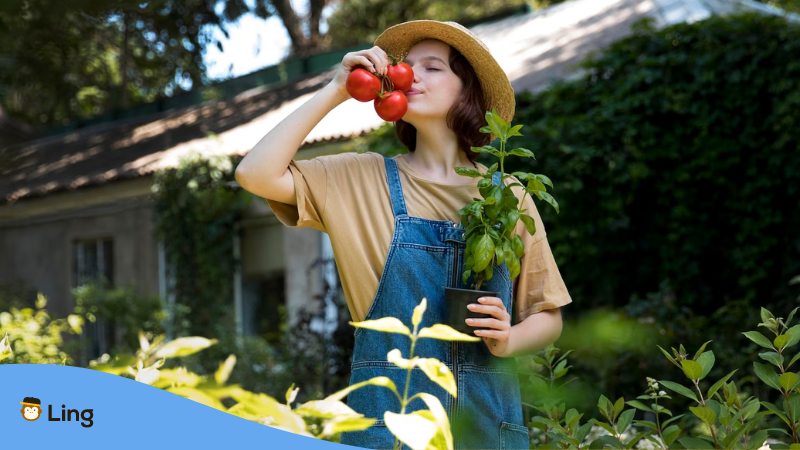
Mango – Amb (ਅੰਬ)
The king of fruits – Mango or Amb (ਅੰਬ), is widely loved in Punjab for its juicy and delicious taste. It’s used in various dishes, including pickles, chutneys, and desserts. Mangoes are also a good source of vitamins A and C, promoting healthy skin and eyes.
Apple – Seb (ਸੇਬ)
Apple or Seb (ਸੇਬ) is a popular fruit in Punjab and is known for its nutritional benefits. Apples are often used in desserts, salads, and juices. They’re rich in fiber and antioxidants, supporting heart health and digestion.
Cashew – Kaju (ਕਾਜੂ)
The Kaju (ਕਾਜੂ) tree produces tasty cashew nuts, which are a staple in many Punjabi dishes. Cashews are rich in vitamins and minerals and promote a healthy heart and strong bones.
Tomato – Tamaatar (ਟਮਾਟਰ)
Tomato or Tamaatar (ਟਮਾਟਰ) is an essential ingredient in Punjabi cuisine, adding flavor and color to curries, salads, and chutneys. Tomatoes are a wealthy source of vitamins A and C, promoting a healthy immune system and skin.
Potato – Aaloo (ਆਲੂ)
A versatile vegetable, potato or aaloo (ਆਲੂ) is used in countless Punjabi dishes, such as aloo paratha and aloo gobi (curried potato and cauliflower). Potatoes are a good energy source, providing complex carbohydrates, fiber, and vitamin C.
Radish – Mooli (ਮੂਲੀ)
The radish or mooli (ਮੂਲੀ) is a popular vegetable in Punjab, often eaten raw or cooked in dishes like mooli paratha or mooli achaar (radish pickle). Radishes are fiber-rich and low in calories, supporting healthy digestion and weight management.
Flowers
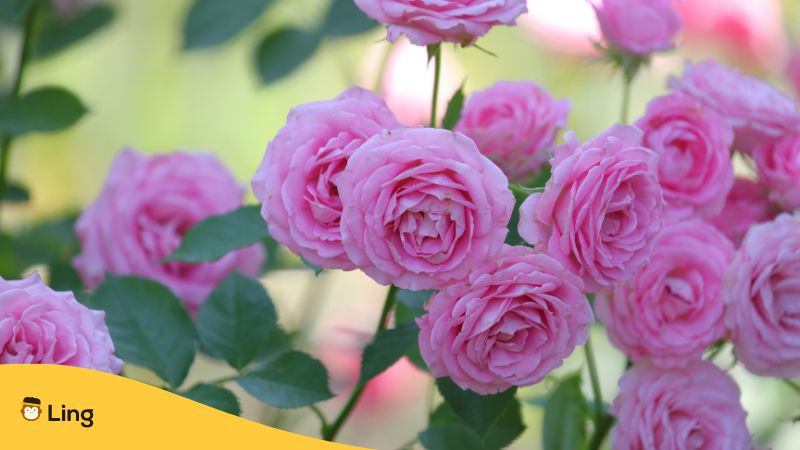
Rose – Gulab (ਗੁਲਾਬ)
The fragrant rose or gulab (ਗੁਲਾਬ) is a symbol of love and beauty in Punjabi culture. Its petals are used to make rose water and gulkand, which have cooling and digestive properties.
Jasmine – Chameli (ਚਮੇਲੀ)
Jasmine or chameli (ਚਮੇਲੀ) is cherished for its intoxicating fragrance and delicate white blossoms. Jasmine flowers are used for making garlands, perfumes, and essential oils that promote relaxation and mental well-being.
Marigold – Genda (ਗੇਂਦਾ)
The vibrant genda (ਗੇਂਦਾ) is a bright flower in Punjabi culture, often used in religious ceremonies and weddings. Marigold petals have antiseptic and anti-inflammatory properties and can be used to cure minor skin irritations.
Lotus – Kamal (ਕਮਲ)
Kamal (ਕਮਲ) or Lotus is a symbol of purity and enlightenment in the Indian culture. Therefore, it holds great cultural significance in Punjab as well. Its edible seeds, roots, and leaves are used in traditional cooking as well as in traditional medicine to treat different ailments, such as fever, digestive issues, and skin conditions.
Common Plants In Punjabi Terminology
As we continue our lively exploration of plants in Punjabi, it’s time to discuss the plant terminology in the Punjabi language.
This fascinating linguistic realm is filled with delightful words that capture the essence of the plants they describe.
Let’s look into some common terms and phrases that will help us better understand the captivating flora of the Punjabi regions.
Plant Parts And Their Functions
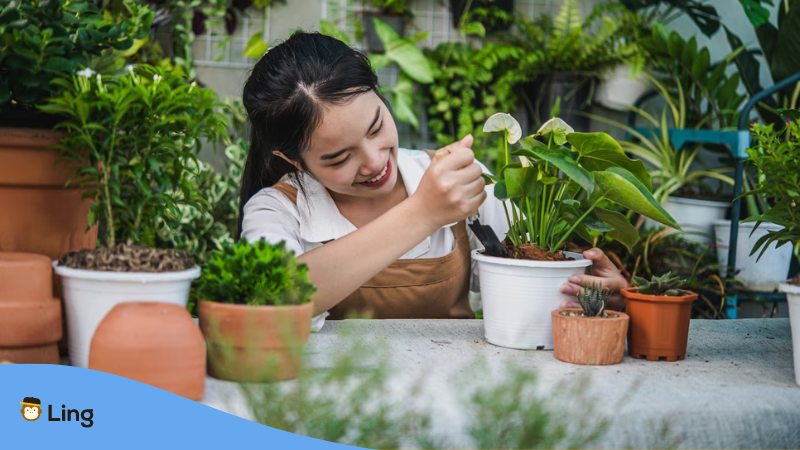
Plant – Boota ਬੂਟਾ
A boota (ਬੂਟਾ) refers to any living thing that typically makes its food from sunlight. An example is the vibrant sarson (ਸਰਸੋਂ) or mustard plant, which adds a burst of yellow to the fields of Punjab. Mustard fields are postcard images for Punjab.
Sapling – Paudha (ਪੌਧਾ)
A paudha (ਪੌਧਾ) is a young plant that’s just starting to grow. Imagine a tiny Bargad (Bargad) or banyan tree sapling, which will one day grow into a magnificent, shade-giving giant.
Branch – Pakkh (ਪੱਖ)
Pakkh (ਪੱਖ) is the Punjabi word for the parts of a tree that extend out from the trunk. For instance, the sturdy branches of a Shehtoot (ਸ਼ੇਹਤੂਤ) or mulberry tree provide a perfect spot for birds to perch and sing.
Leaf – Patta (ਪੱਤਾ)
A patta (ਪੱਤਾ) is the green, flat part of a plant that helps it make food from sunlight. The large, heart-shaped leaves of the kamal (ਕਮਲ) or lotus plant, for example, gracefully float on the surface of ponds.
Stem – Pushal (ਪੁੱਛਲ)
The pushal (ਪੁੱਛਲ) is the main body of the plant that supports the leaves, flowers, and fruits. Take the surajmukhi (ਸੂਰਜਮੁਖੀ) or sunflower plant, with its robust and upright stem that holds up its bright, cheerful flower.
Flower – Phull (ਫੁੱਲ)
Phull (ਫੁੱਲ) refers to the colorful, often fragrant part of a plant that is responsible for reproduction. The gulab (ਗੁਲਾਬ) or rose, with its velvety petals and sweet aroma, is a beloved flower in Punjabi culture.
Fruit – Phal (ਫਲ)
A phal (ਫਲ) is part of a plant that contains seeds and is usually edible. The aam (ਆਮ) or mango, known as the king of fruits, is a delicious and much-anticipated summer treat in Punjab.
Seed – Beej (ਬੀਜ)
Beej (ਬੀਜ) are the small parts of a plant that can grow into a new plant. The tiny, round seeds of Alsi (ਅਲਸੀ) or flax plant, for instance, are packed with nutrients and often added to Punjabi dishes.
Root – Jar (ਜੜ)
Jar (ਜੜ) refers to the part of a plant that grows underground and absorbs water and nutrients. The adrak (ਅਦਰਕ) or ginger root, for example, is not only a key ingredient in many Punjabi recipes but also boasts numerous health benefits.
General Plant Terminology
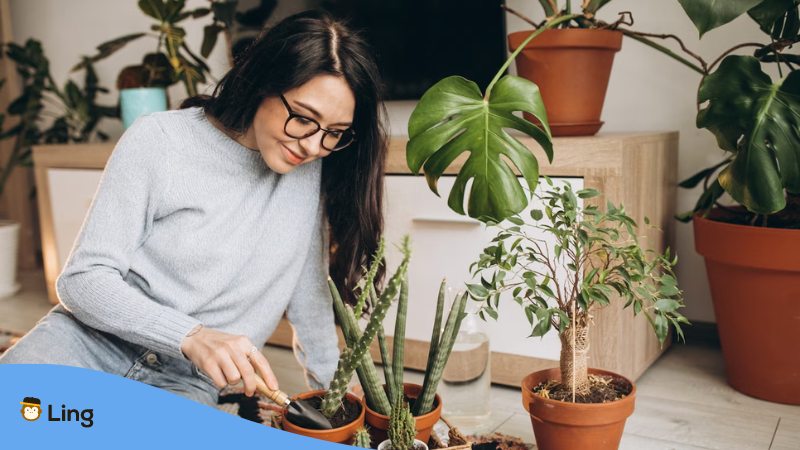
Deciduous – Patjhar (ਪਤਝੜ)
Deciduous plants, or patjhar (ਪਤਝੜ), shed their leaves during a specific season, usually autumn, to conserve water. The word literally is a union of pat (leaf) and jhar (to shed). The peepal (ਪੀਪਲ) or sacred fig tree is a deciduous tree native to Punjab, providing shade and spiritual significance in the region.
Evergreen – Sadabahar (ਸਦਾਬਹਾਰ)
The sadabahar (ਸਦਾਬਹਾਰ) trees, as their name suggests, keep their leaves all year round. The cheer/ cheedh (ਚੀੜ) or longleaf pine tree, commonly found in Punjab, is an evergreen tree that offers a lush green backdrop even during winter.
Pollination – Biyani (ਬਿਆਨੀ)
Pollination, or biyani (ਬਿਆਨੀ), is the process by which plants transfer pollen from one flower to another, leading to fertilization.
Bees play a vital role in pollinating the vibrant gulab (ਗੁਲਾਬ) or rose flowers, ensuring the continuation of these lovely blooms.
Fertilization – Paragan (ਪਰਾਗਣ)
Paragan (ਪਰਾਗਣ), or fertilization, occurs when a pollen grain fuses with an egg cell, resulting in the production of seeds. The Surajmukhi (ਸੂਰਜਮੁਖੀ) or sunflower relies on this process to produce its delicious, nutritious seeds.
Berry – Beri (ਬੇਰੀ)
A beri (ਬੇਰੀ) is a small, juicy fruit containing multiple seeds. The angoor (ਅੰਗੂਰ) or grape, for instance, is a popular berry in Punjab, enjoyed for its refreshing taste and used in the production of delicious juice.
Bud – Mukul (ਮੁਕੁਲ)
A mukul (ਮੁਕੁਲ) or bud, is the early stage of a flower or leaf’s growth. The tightly curled buds of the jasmine flower eventually open up into delicate, fragrant blossoms.
Ornamental Garden – Sohna Bagh (ਸੋਹਣਾ ਬਾਗ਼)
A ਸੋਹਣਾ ਬਾਗ਼, or ornamental garden, is a carefully designed outdoor space filled with a variety of colorful and aesthetically pleasing plants.
The famous ਪਿੰਜਰ ਬਾਗ਼ (Pinjore Bagh) or Pinjore Gardens in Punjab is a prime example of a ਸੋਹਣਾ ਬਾਗ਼, showcasing a stunning array of flowers, trees, and shrubs that delight the senses and offer a peaceful retreat for visitors.
The Importance Of Understanding Plant Names In Punjabi
The Punjabi language, with its rich expressions and vibrant phrases, serves as a magical bridge connecting the people to the plants that surround them.
As we master the plant terminology in Punjabi, we’ll gain a deeper appreciation of the thriving botanical heritage of this region and uncover the delightful stories behind each plant.
Difference Between Plant Names In Punjabi And Hindi
You might be surprised to learn that Punjabi and Hindi, sibling languages in the Indo-Aryan family, have a lot in common regarding plant names.
Take the mango, for example; it’s called ਅੰਬ (Amb) in Punjabi and आम (Aam) in Hindi.
But it’s not all the same—there are differences too.
The sacred fig is known as ਪੀਪਲ (Peepal) in Punjabi and पीपल (Peepal) in Hindi.
Little variations highlight the unique charm of each language and the cultural context they come from.
Learn The Plants In Punjabi With Ling!
As we wrap up our exploration of plants in Punjabi, it’s evident that this article has uncovered a delightful interplay between nature, language, and our cherished cultural heritage.
By immersing ourselves in these essential terms and appreciating the role of the Punjabi language in plant names, we deepen our connection to the environment and strengthen our unique cultural identity.
So, the next time you come across a ਬੋਹੜ (Bohrr) tree or enjoy a tasty ਅੰਬ (Amb) fruit, take a moment to appreciate the beautiful linguistic and cultural tapestry that connects us to the world of plants in Punjabi.
Are you feeling inspired to learn more about the Punjabi language and its connection to plants? Don’t wait another moment!
The Ling app is one of the best free learning applications to help you master a new language in just 15 minutes a day from your phone.
Download the Ling app from Google Play and App Store now!
